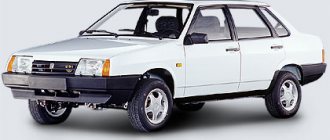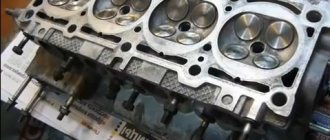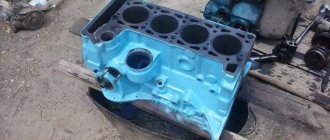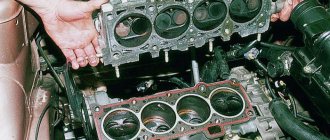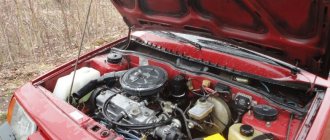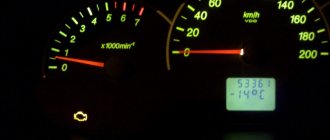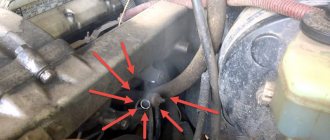During operation, the main indicators of the good condition of the internal combustion engine are the sound of the engine, the stability of the unit in different modes, the absence of problems with starting, etc. As for extraneous noise during engine operation, the appearance of various sounds may indicate the occurrence of certain malfunctions. These faults should be divided into two groups. The first includes breakdowns that do not pose a great threat to the main components and assemblies of the internal combustion engine itself. The second includes sounds that directly or indirectly indicate a high probability of serious engine failure, which leads to the need for major repairs or replacement of the existing power plant with a new engine, a used unit from a “donor”, a contract engine, etc.
We also recommend reading the article about what a contract engine is. From this article you will learn about the advantages and disadvantages of units of this type, and also find answers to questions about where and how to choose and then buy a contract motor.
There can be many reasons for engine knocking in the engine compartment, ranging from wear of drives or attachment rollers to knocking of valves, hydraulic compensators and other timing elements. As for the question of when there is knocking inside the engine itself, it could be the pistons, crankshaft, connecting rods and other components of the CPG. Let's take a closer look at the possible causes of engine knocking.
Bottom line
Car enthusiasts often encounter the problem of engine seizure.
It is important to pay attention in time to the unnatural behavior of the machine. If it doesn’t start once, and then everything gets better, this does not mean that the problem has resolved itself. It is highly likely that you will encounter this problem again, only this time it will take on a different scale.
With a high probability, you will encounter this problem again, only this time it will take on a different scale.
- Next Car pump malfunctions: causes, consequences, prevention
- Back What you need to know about electronic window tinting
- Sep 4, 2019
- Sep 4, 2019
- Safety/Tips
Sep 4, 2019
- Audi crossovers / News
Sep 4, 2019
- Sep 3, 2019
- Sep 3, 2019
- April 13, 2019
- March 12, 2019
- Feb 17, 2019
- April 11, 2019
- News/Reference information
Jun 22, 2019
How to find out what is knocking in the engine Auto magazine
How to find out what is knocking in the engine?
It's no secret that over time the engine wears out and, depending on its service life, malfunctions periodically arise that can lead to repairs.
As a rule, if you hear any extraneous knocking or noise in the engine, you immediately contact Opel services with a request to determine and eliminate the cause of the extraneous sounds. Well, what if there is no way to contact the service? Is it possible to determine the cause of extraneous noise or knocking in the engine?
Of course you can! And many car enthusiasts do this themselves in order to avoid expensive diagnostics when contacting a car service center. You can do this too and determine with sufficient accuracy the cause of extraneous engine knocks. In identifying extraneous engine knocks, a car stethoscope will come to your aid. In the absence of the above, you can resort to ordinary medical help. Or make a homemade device from available materials, for example, a plastic bottle, a piece of tube and an ordinary bolt.
Once you have decided on the choice of stethoscope, you can begin troubleshooting. Engine malfunctions due to wear and tear can be very different, and to know them exactly, you need to at least read the manual for your engine and know its structure. After all, without an exact understanding of what and how it spins and moves in your engine, what gears and bearings are installed in it and where they are located, no stethoscope will help you. But maybe you will be pleased that with the acquisition of some experience, you will be able to diagnose the engine no worse than any specialist from a car service center
Below are some faults that you can detect yourself and which you need to pay attention to first of all
The occurrence of knocking of the pistons in the cylinders.
This malfunction is typical for dull and clicking sounds when starting a cold engine when the accelerator pedal is suddenly released and the engine speed is reduced. When the engine warms up, the knocking noise usually disappears. Knocks can be clearly heard in the area of the cylinder block.
The occurrence of knocking piston pins.
A loud metallic knock will appear when you sharply change the throttle, decrease or increase engine speed. Probably the most common knock. May appear after filling with low-quality fuel. They can be heard in the area of the cylinder block, and disappear when the spark plugs are unscrewed, as the load on the piston disappears.
The occurrence of knocking noises from the main bearings.
They usually appear when the crankshaft liners wear out. They can be heard well in the crankcase area, like knocking with a well-defined metallic tint. They are especially clearly audible when the oil pressure in the engine crankcase is low. Therefore, never fill the crankcase with oil that is not recommended by the manufacturer. If you do fill it up and characteristic knocking noises begin to appear, then immediately change the oil to the recommended one and thoroughly flush the engine.
The occurrence of knocking of the connecting rod bearings.
It is characterized by the same knocking noises as the main bearings, but with a more pronounced character. If knocking noises characteristic of the last two subparagraphs occur, the engine may jam. Therefore, timely oil changes are recommended. There is no need to save on cost, but buy really high-quality oils from well-known brands. And one last piece of advice. Don't be discouraged if you couldn't immediately identify an engine malfunction based on extraneous noise. All comes with experience. You can contact a specialist and ask for help. Or go to the nearest car service center and see how they carry out diagnostics there. In any case - go for it! Learn! Experience will definitely come.
Also, look:
- Preparing your car for winter
- Muffler repair
- All about car radiator repair
- 5 “disadvantages” of an automatic transmission
https://auto-diary.ru
Signs of jamming
The engine will immediately signal a problem, and in this case movement is impossible. Often, when a malfunction occurs, drivers blame a dead battery, but charging it is not always able to fix the problem. There are certain symptoms that indicate a problem, which is jamming of motor elements.
This is often indicated by a click from the starter relay, after which the crankshaft stops rotating. The cause may be a dead battery or a malfunction of the starting mechanism. While driving, a sudden jamming of the engine can occur, then it immediately stalls, or a gradual loss of power, then the engine stops. It will no longer be possible to start the car again; the starter does not turn, and when trying to start the engine, a grinding and clanging of metal is heard. Sometimes, after inactivity, the unit still starts, but even if the startup is successful, if the problem is not resolved, you can no longer count on its normal and long-term operation. Often, before a jam, you can hear a rumble and the sound of metal parts hitting each other from under the hood.
Tough diesel operation
Previous13Next
One of the main features of the combustion process in diesel engines is the “hardness” of operation. Since in the initial period of the second combustion phase a significant amount of fuel burns at high speeds, a significant increase in gas pressure on the piston occurs. “Hard” engine operation refers to a working process in which the combustion pressure in the cylinder increases extremely quickly.
It would seem that the “harder” the work, the more power should be developed and the efficiency of the engine should improve, since under these conditions the losses associated with imperfect combustion dynamics should be reduced. However, this causes an increase in dynamic loads on the parts of the crank mechanism, the appearance of vibration and reduces the durability of the engine.
The “hardness” of engine operation is assessed by an increase in pressure per degree of crankshaft rotation angle:
The average value of the “hardness” of diesel engines (∆p/∆φ) avg is usually 1-1.5 MPa/°.
The operation of carburetor engines is also characterized by a certain “hardness”, but it is only 0.2-0.3 MPa/°.
The more fuel prepared for ignition is in the cylinder, the more heat is released in the second phase of combustion, and the greater the “hardness” of the engine.
When developing a diesel engine, they strive to ensure effective heat transfer with moderate “rigidity” of its operation, without exceeding permissible values.
An example of “hard” operation of a diesel engine is its operation during warm-up, especially at low ambient temperatures. Under these conditions, the auto-ignition delay period is prolonged, which leads to high values of ∆ p
/∆φ.
Expansion process
Purpose and course of the expansion process
The expansion process is the only process in the work cycle during which useful work is performed. It begins with the beginning of a decrease in pressure in the cylinder and ends when the piston reaches BDC.
Expansion occurs when the heat exchange surface area changes, as well as the pressure in the space above the piston and is accompanied by the loss of a small amount of the working fluid through the ring seals.
In the initial stage, expansion occurs with the supply of heat, since at this time afterburning ends and an increase in temperature is observed. Therefore, the value of the expansion polytropic exponent n
2 below the expansion adiabatic exponent k
2, in some cases even less than 1. As the piston moves to BDC, the afterburning process subsides and heat removal into the cylinder walls begins to predominate.
In this case, n
2 increases, approaching the value
k
2.
At a certain position of the piston, the heat removal and at the same time the continuing but weakening heat supply become equal: n
2 =k
2.
With further expansion, heat removal from the working fluid begins to dominate, and n
2 becomes greater than k
2.
Thus, expansion should be considered as a polytropic process with a variable expansion polytrope index n
2 (Fig. 20).
Rice. 20. Change in the process of expanding indicators T, p
,n
2 and
k
2.
Due to the difficulty of using variable values of n
2, when performing thermal calculations of engines, the conditional average value of the expansion polytropic index is used.
Depending on the type of engine and its operating mode, the average values of the expansion polytrope vary from 1.18 to 1.32.
When considering the influence of various factors on the expansion process, it should be borne in mind that the smaller the value of n
2, the flatter the indicator diagram will be, which means more useful cycle work will be obtained.
The expansion process is influenced by the following factors:
1. Crankshaft rotation speed. As the crankshaft rotation speed increases, the time of contact of the working fluid with the cylinder walls and gas leakage through the gaps between the piston and cylinder are reduced, which leads to a decrease in the value of n
2.
2. Load. In carburetor engines, as the load increases, the value of the indicator n
2 remains almost unchanged; in diesel engines this indicator decreases due to an increase in the afterburning phase.
3. Cylinder dimensions. At a constant cylinder displacement with increasing S/D
value of indicator n
2 decreases.
4. Combustion chamber design. As the size of the combustion chamber increases, heat removal from the working fluid increases, so the value of the index n
2 increases.
5. Technical condition of the engine. When the cylinder-piston group wears out, leakage of the working fluid increases, which is similar to heat removal. Therefore, in worn-out engines the value of the indicator will be higher than in engines in good technical condition.
Previous13Next
Date added: 2017-02-13; ; ORDER A WORK WRITING
Mechanical wear
The main reason for the wedge in domestic cars is internal loose fastenings in the engine due to poor-quality lubrication and its non-periodic replacement. The nuts of the main bearings, timing belt tensioner, and connecting rod head nuts may become loose. After a makeshift overhaul, the retaining ring may come out of the piston. The reason for this is non-standard spare parts.
A crumbled valve can be checked visually by removing the engine cover. Often a spring flies out or the valve itself bends when the timing belt breaks. Malfunctions occur when the cylinder head is tightened without a torque wrench, when a crack appears in the walls due to overstrain and, accordingly, the pressure on the lubricant drops. The likelihood of engine wedge increases with excessive loads while driving.
General questions and crankshaft knock
Signs that the engine has knocked. Everything is much more complicated with
and stronger due to the fact that during the stroke the pistons come close to the cylinder block, or rather its head. Over time, the piston will simply hit the block and make a dull sound. It is strictly forbidden to drive such a motor, otherwise prepare money for a new one. Of course, you can get a couple of kilometers home, but no more, and then with a Subaru engine and the EA-81.82 model.
The design of such a unit is strong and durable due to the short crankshaft. Remember, the cause of the knocking noise can be an arbitrarily unscrewed connecting rod nut, which can grind the engine floor. For a new power unit, the gaps between the connecting rods are 0.02 microns, and for a worn one, 0.07 microns. It would seem nonsense, but it plays a role.
Prevention
To avoid motor jamming and other problems, you should follow a number of simple recommendations:
- It is necessary to regularly monitor the level and condition of the engine oil, and also replace it in a timely manner. In addition to the lubricant, the oil filter also needs to be changed;
- Monitoring the coolant level will also protect against overheating. The volume of antifreeze in the expansion tank is checked with a cold engine;
- If there is knocking in the motor or other extraneous sounds, the movement must be stopped immediately, without waiting for the unit to stall on its own.
Thus, most of the reasons leading to jamming of engine elements can be prevented
This is a common problem, but if you take the time to care for your car and pay attention to the uncharacteristic behavior of the unit, you can avoid many problems
What to do if it’s the crankshaft that’s knocking?
If you experience a strong metallic knock, but the engine is still running, consider yourself lucky! This means that the liner has turned, but has not jammed, otherwise you will no longer be able to start your unit. It’s not uncommon for a “wedge” to tear out a piece of the engine block. We urgently turn off the car and urgently go to the service station. You won’t be able to do anything yourself, unless of course you are a “motor guy”.
What will the technicians do at the service station:
1) Drain the oil and remove the engine.
2) They will disassemble the block and pull out the crankshaft.
3) Further, in terms of the complexity of the process - if this HF is still usable (no severe scuffing in the journals), then it can be polished (attachment points) and thicker liners can be installed. If the damage is critical, it goes to a landfill, and you buy a new one, along with new liners.
The process is very labor-intensive and requires a qualified craftsman, otherwise there is a chance that this will happen again. Don't skimp on this type of repair!
I will finish, remember - if the knock is metallic and very strong, this is very bad, we react urgently, we take it - and do not go to the service station!
Source


